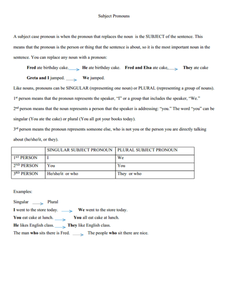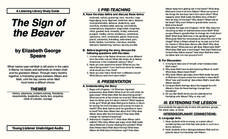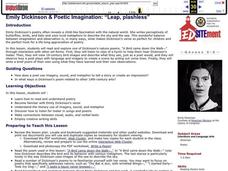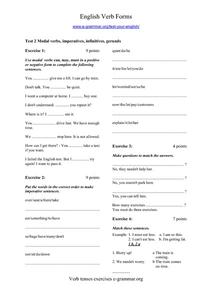Savvas Learning
Pronouns
As part of their English grammar study, language learners engage in the games, exercises, and activities found in a 13-page packet that focuses on pronouns.
Curated OER
Life Snapshots
Young scholars create Inspiration webs using graphics or photographs that depict high and low points in their lives. This technology-based Language Arts lesson for the upper-elementary or middle-level classroom is excellent for improving...
K12 Reader
What Do You See? (Inferences)
Making inferences is a skill that goes beyond the comprehension of written text. In this simple exercise, young learners are provided with a photograph and asked to answer a series of inference questions using only on the information...
K5 Learning
Finders Keepers
If you found five hundred dollars in the park, would you keep it or turn it in? Exercise both reading comprehension skills and philosophic beliefs in a language arts reading activity about three boys who stumble upon a small fortune —...
Curated OER
Five Quick Games Build Reading Skills
Build reading skills with these five quick games! Whether you're hoping to build grammar, syllabication, or word recognition skills, this resource has options for you. Kids will love taking a break from the mundane to play these...
Curated OER
Telecommunications and the Whole Language Program
Young writers use technology and other media to research information on a chosen topic. They explore countries where keypals and e-mail friends are located. Using their writing skills, they correspond with their e-mail friend and...
Curated OER
Match the Song Lyrics - "Keep Going"
Oh no, we're missing several lines of lyrics! Using the song, "Keep Going," test the listening skills of your English language learners. They listen as you say the word lyrics aloud. Can they correctly identify the missing lyrics?
LearnEnglishFeelGood.com
Choose the right preposition for each phrasal verb
Clarify the meanings of ten sentences with a fill-in-the-blank worksheet. As young grammarians study the context clues in each sentence, they choose which preposition would best complete the thought.
Listening Library
The Sign of the Beaver
Extend a class reading of the novel The Sign of the Beaver across all subject areas with this literature unit guide. From basic discussion questions and writing prompts, to a research project about tracking animals, this resource offers...
Curated OER
Developing Writing Skills Through Japanese Folk Music
Students listen to Japanese folk songs to get inspired to create a writing piece about Japan. In this writing lesson, students use primary and secondary sources to add information about Japan.
Curated OER
"Leap, Plashless": Emily Dickinson & Poetic Imagination
Students read and explore one of Emily Dickinson's nature poems, "A Bird Came Down the Walk-" through interaction with a variety of art forms. Clips of a hymn to hear meter and the viewing of bird images exposes them to the language and...
Curated OER
Test Your Speaking & Listening Skills
Learners match 15 Derbyshire slang phrases with their meanings. When it comes to distinguishing the contexts for formal and informal English, any time you'd use this language, the context is definitely informal.
Worksheet Web
Interrogatives and Auxiliary Verbs
Interrogatives—who, what, where, when, why, and how—are the focus of a grammar worksheet that reinforces writing questions and using auxiliary verbs.
Worksheet Web
Heteronyms
Challenge scholars to identify and use heteronyms in a sentence with a two-page activity designed to boost grammar skills.
Curated OER
Context Skills
Here is a fine lesson plan on teaching ways to use context clues. Upper graders split up into groups and use sticky notes to cover up five words in a passage of text. The passages are rotated to the other groups, and learners must use...
Curated OER
Edward Lear, Limericks, and Nonsense
Introduce your class to the delights of nonsense poetry and explore literary devices with the writing of Edward Lear. Learners identify rhyme and meter as well as figures of speech, alliteration, and onomatopoeia in "The Owl and the...
Curated OER
Go Free or Die
Groups of older elementary learners begin their study of figurative language by visiting a website and completing the exercises detailed there. They then apply what they have learned by finding examples in several poems. Finally, they...
Florida Center for Reading Research
Vocabulary: Word Meaning, All For One
Given a deck of cards with different words printed, pairs draw cards and work together to locate definitions for each multiple-meaning word. Learners complete a worksheet that challenges them to write the word, two of its definitions,...
Southern Illinois University
Subject-Verb Agreement
Your writing lessons may be all about solid arguments, but in grammar, it's all about agreement! Learners practice identifying proper and improper verb form in a worksheet focused on subject-verb agreement and indefinite pronouns.
National Park Service
The Poet's Toolbox
If you need a lesson for your poetry unit, use two poems by Henry Wadsworth Longfellow ("Rain in Summer" and "The Slave in the Dismal Swamp") and a resource on Elements of Poetry. The lesson plan guides you through activities on...
Curated OER
English Verb Forms
Challenge young grammarians with a short assessment on verbals. As your class progresses through each exercise, they demonstrate understanding for modal verbs, imperatives, infinitives, and gerunds.
Curated OER
Beginning Daily Activities Unit
Begin each day with a warm-up that has ELLs focusing their minds on a skill that will be taught that day. Focusing on verbs, each daily lesson reinforces study and self-management skills, helps learners become proficient in working with...
Houghton Mifflin Harcourt
Give It All You’ve Got!: Extra Support Lessons (Theme 2)
Understanding word parts can play a crucial role in understanding a word in the context of a larger text. A series of extra support resources designed to accompany Theme 2: Give It All You've Got offers activities related to grammar and...
Curated OER
Digital Storytelling
Scholars of all ages can use the various tools of technology to construct and illustrate a story. Utilizing this resource, learners work with a partner to brainstorm and draft a story based on personal experience. They use computer...

























